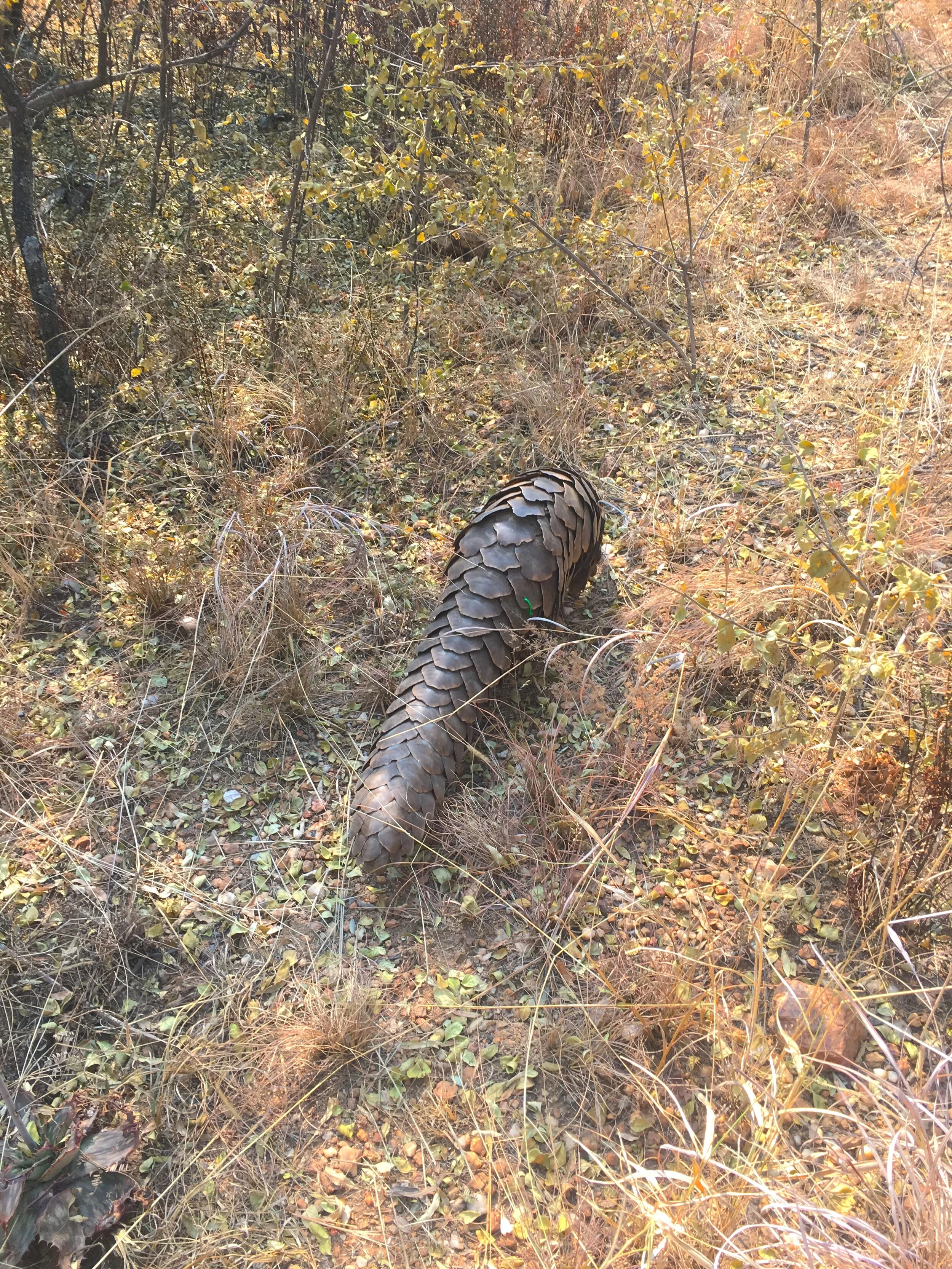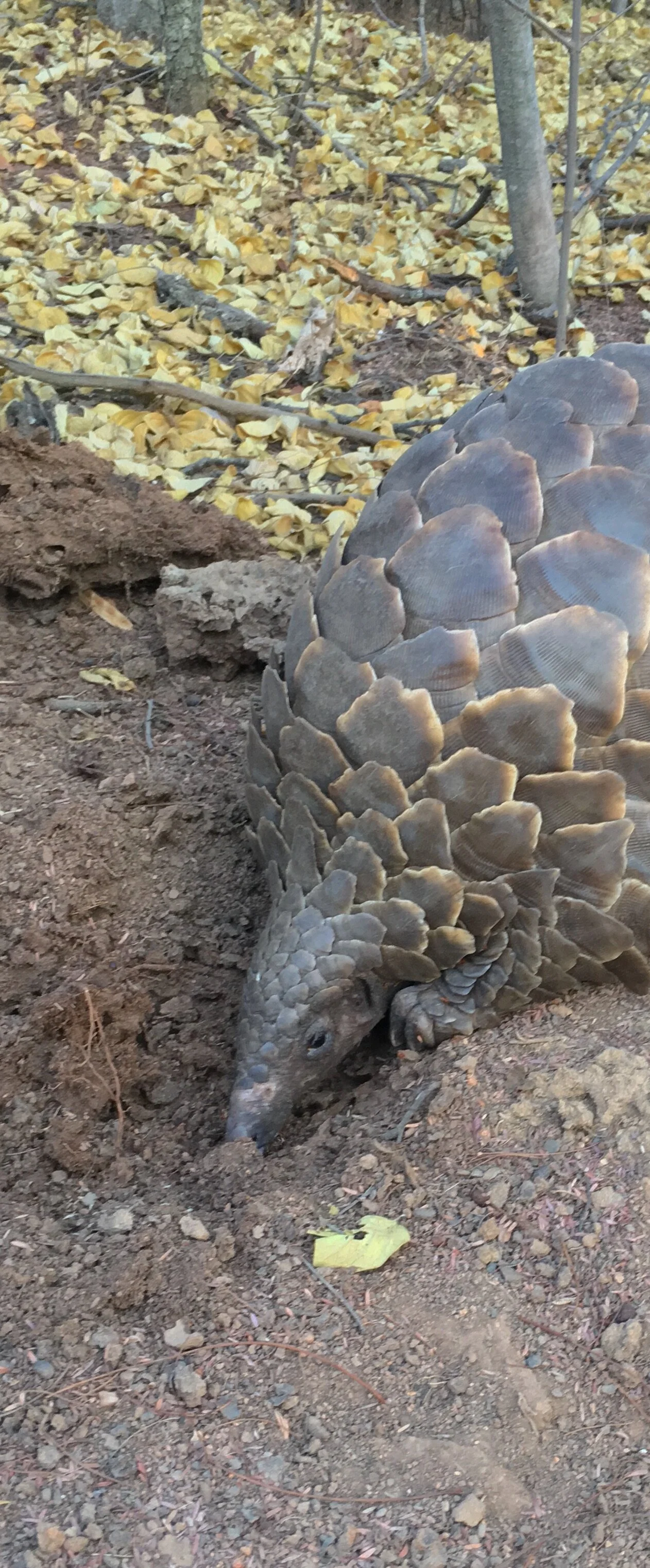PANGOLINS
I walked along in the late afternoon warmth carrying an umbrella. I was following a little creature just ahead of me, trying to make sure that he stayed as shaded from the sun as possible, because he really wasn’t meant to be awake at this time of day, but he was a bit of an unusual case. Before 2019 I had never seen a pangolin. They lived in the sort of mythical bushveld realm of creatures including narina trogons and African wild cats which are barely seen and rarely requested by guests. But now I was in charge of one, making sure that he ate enough so that he could recover from the hardships he had been through.
Pangolins are fascinating creatures. Scaled on one side, soft on the other with a penchant for black ants and a tendency to curl in to a ball if anything gets too much. They are beautifully innocent and curious creatures but they have a price on their heads. There are 8 known species of pangolin split evenly across Asia and Africa. All but one of the Asian species are critically endangered and the African species are either endangered or considered vulnerable. The one I was taking for a walk was a Temminck’s ground pangolin, aka a cape pangolin. This individual, along with the rest of the pangolins on the planet, have been the target of intense poaching due to a massive demand from south east Asia for both their meat and scales.
“PANGOLINS ARE THE MOST INNOCENT, SHY, CAPTIVATING CREATURES, AND YET THEY ARE BEING HUNTED AND POACHED INTO EXTINCTION. THE INJUSTICE IN THAT SHOULD COMPEL US ALL TO ACTION”
Baille J.E.M., 2020
The Convention on International Trade in Endangered Species of Wild Fauna and Flora (aka CITES) is responsible for setting regulations regarding the trade of species. 183 nations have ratified its agreement so its pretty close to being global. CITES works by listing species in one of three appendices. In 2018, all parties agreed to set all pangolin species in appendix 1 - the highest level of protection that a species can receive, essentially meaning that all commercial international trade is banned. However, banning trade doesn’t remove demand. In fact, sometimes it just leads to an intensification of poaching to supply the demand…such as the case with the pangolin…leading to this animal winning the unfortunate title of “most trafficked wild mammal in the world”. Between 2017 and 2019, 96 tons of pangolin scales were seized in south east Asia. Just over a month ago a further 6 tons were seized in Malaysia. The trade in these species might be illegal but there is still a demand which has driven a surge in poaching to supply the continued demand for this animal’s products.
In south east Asia the meat of the pangolin is used to demonstrate social hierarchy and status, much like caviar is in the western world I suppose. Pangolin scales, which are made of nothing more than keratin, the same stuff our hair and fingernails are made of, have been used in traditional Chinese medicine for centuries to treat poor blood circulation and arthritis, amongst other health issues. There is no evidence to show that keratin has any health benefits whatsoever. As trading of this species is now illegal thankfully, the use of pangolin products in traditional Chinese medicine has come under severe scrutiny in recent years. This scrutiny was having an effect but it was chivvied along by a nice little pandemic which stopped the world in its tracks.
When the COVID-19 outbreak first appeared there was lots of research committed to finding out where it had come from. Evidence pointed towards pangolins. While now most agree that it came from bats, pangolins are considered to be an intermediary. Such a discovery was undoubtably the final straw on top of a pile of frustrations regarding the continued use of pangolins in traditional medicine. As only last week, China removed pangolin scales from their list of approved medicines on the basis of ‘wild resource exhaustion’. This is an extremely powerful step which hopefully is the start of a cultural change in the use of wild animal products for medicine. But it is the very fact that the use of these products is cultural which means that this isn’t something which will change overnight. It now needs reinforcement to ensure that the use and therefore illegal trade and therefore poaching will stop. I’m not taking away from the fact that traditional Chinese medicine has a lot to offer and I believe that western medicine can learn a lot from eastern practices, but there is absolutely no justification for driving an animal to extinction due to human need. I have travelled extensively and I believe cultural diversity is one of the most beautiful features of this planet. But we all have a responsibility to protect wildlife, especially that which our actions are directly affecting.
The little pangolin which I took for a walk to me was representative of the 8 species as a whole. He was pure innocence, protected by those doing good in the world, but fighting to outrun a dark, threatening shadow. Just like most species on the planet, pangolins need all the help that they can get. It is our responsibility to make sure that they are protected. This is why it’s so important for travellers to be educated about wildlife trade and its implications. Wild areas that you visit to view wildlife are not pristine but by visiting them with an educated mindset you can ensure that your trip contributes in a positive way to the future of biodiversity conservation.

